From Spatial Representation to Participatory Engagement: Designing a UCD–BDD Virtual Pilgrimage Environment
Abstract
1. Introduction
- 1.
- Contextual Inquiry: Identify user needs, ritual practices, and cultural context through a literature review and on-site observations.
- 2.
- UCD–BDD Scenario Design: Apply UCD principles to aligning interaction concepts with user abilities and cultural backgrounds and use BDD to define key ritual nodes and formulate Gherkin-based interaction scripts.
- 3.
- Prototype Development: Construct the virtual Boudhanath Stupa in Minecraft, integrate embodied VR interaction, and ensure symbolic, spatial, and sensory fidelity.
- 4.
- Formative Evaluation: Test the prototype with 50 participants from diverse backgrounds and 2 Tibetan Buddhist experts, combining quantitative and qualitative methods to assess its usability, engagement, and cultural appropriateness.
2. Related Works
2.1. The Cultural and Ritual Context of Pilgrimage
2.2. Previous Virtual Pilgrimage Practices
- 1.
- Mechanics of Interaction: This dimension assesses the fundamental modes of interaction provided by the system. We examine the complexity and variety of its mechanics, ranging from basic visual navigation such as clicking, dragging, and app-based text responses to more complex gamified mechanisms, including 3D character navigation, quest systems, and embodied VR gesture controls. The goal is to understand the level of physical and functional interactivity the platform offers to users.
- 2.
- Dynamics of Ritual: This dimension evaluates the system’s effectiveness in reproducing authentic patterns of pilgrimage behavior. We analyze whether the experiential flow generated by the platform leans toward linear information delivery and script-driven task sequences or supports user-constructed, non-linear, performative rituals.
- 3.
- Aesthetics of Pilgrimage: This dimension examines the spectrum of emotional and spiritual experiences evoked by the platform. We assess whether its aesthetic engagement primarily centers on sensory pleasure (sensation) and a sense of exploration (discovery) enabled by high-resolution imagery or whether it extends to more faith-related expressions of devotion (expression) and commitment (submission), as well as more diverse aesthetics such as narrative or fellowship.
- 4.
- User Control and Freedom: This dimension assesses whether users are provided with strong, moderate, or limited autonomy during the experience. It considers the linearity of pathways, the level of control over pacing, and the range of choices in ritual interactions to evaluate the potential for constructing a personalized experience.
2.3. Methodological Frameworks: UCD and BDD
2.4. Platforms for Accessibility and Immersion: Minecraft and VR
3. Design and Methods
3.1. Phase 1: Contextual Inquiry and Design Specification
- Prostration—Performing full-body bows to express reverence and devotion;
- Smoke Offering—Burning incense or aromatic plants to purify the space and invite blessings;
- Chanting—The recitation of sacred texts or mantras to accumulate merit and cultivate mindfulness;
- Flower Offering—Presenting fresh flowers as an act of reverence, symbolizing purity and impermanence;
- Prayer Wheel Turning—Rotating large or handheld wheels inscribed with mantras, believed to generate spiritual merit;
- Giving Alms—Providing food or necessities to those in need, including feeding stray animals, reflecting compassion;
- Meditation—Engaging in seated contemplation to cultivate inner stillness and spiritual insight;
- Light Offering—Lighting rows of butter lamps, symbolizing dispelling ignorance and the aspiration for enlightenment.
3.2. Phase 2: Environment Implementation and Prototyping
3.3. Phase 3: The User Experience Protocol
3.3.1. Participants
3.3.2. The Procedure
3.3.3. The Data Collection Instruments
4. Results
4.1. Mechanics of Interaction
4.2. Dynamics of Ritual
4.3. Aesthetics of Pilgrimage
4.4. User Control and Freedom
4.5. Expert Feedback
5. Discussion and Future Research
- Enhancing the guidance and feedback through clearer progress indicators, interactive maps, and meaningful rewards (e.g., unlocking a pure land scene after completing 108 circumambulations);
- Expanding the educational and narrative content with interactive explanations of the stupa’s history, symbolism, and rituals;
- Supporting community co-creation by enabling users to customize or collaboratively build within the environment;
- Implementing multi-user and social features to facilitate shared rituals, guided tours, and educational activities.
Funding
Data Availability Statement
Acknowledgments
Conflicts of Interest
Correction Statement
References
- UNESCO World Heritage Convention: Kathmandu Valley. Available online: https://whc.unesco.org/en/list/121/ (accessed on 2 July 2025).
- Khenpo Tashi Tsering Rinpoche; Guo, R. Pilgrimage to Nepal: Entering Guru Rinpoche’s Hidden Land of Nubri; Oak Tree Publishing Co.: Taipei, Taiwan, 2020; pp. 24–32. [Google Scholar]
- UN Tourism: Impact Assessment of the COVID-19 Outbreak on International Tourism. Available online: https://www.unwto.org/impact-assessment-of-the-covid-19-outbreak-on-international-tourism (accessed on 2 July 2025).
- Yasin, R.; Jauhar, J.; Abdul Rahim, N.F.; Namoco, S.; Enaizan Bataineh, M.S. COVID-19 and Religious Tourism: An Overview of Impacts and Implications. Int. J. Relig. Tour. Pilgr. 2020, 8, 155–162. [Google Scholar]
- Li, Y.; Du, Y.; Yang, M.; Liang, J.; Bai, H.; Li, R.; Law, A. A review of the tools and techniques used in the digital preservation of architectural heritage within disaster cycles. Herit. Sci. 2023, 11, 199. [Google Scholar] [CrossRef]
- Champion, E. Virtual Heritage: A Guide; Ubiquity Press: London, UK, 2021. [Google Scholar]
- Buragohain, D.; Buragohain, D.; Meng, Y.; Deng, C.; Chaudhary, S. A metaverse based digital preservation of temple architecture and heritage. Sci. Rep. 2025, 15, 15484. [Google Scholar] [CrossRef] [PubMed]
- Pagano, A.; Palombini, A.; Bozzelli, G.; De Nino, M.; Cerato, I.; Ricciardi, S. ArkaeVision VR Game: User Experience Research between Real and Virtual Paestum. Appl. Sci. 2020, 10, 3182. [Google Scholar] [CrossRef]
- Ch’ng, E.; Li, Y.; Cai, S.; Leow, F.-T. The Effects of VR Environments on the Acceptance, Experience, and Expectations of Cultural Heritage Learning. J. Comput. Cult. Herit. 2020, 13, 1–21. [Google Scholar] [CrossRef]
- Ferdani, D.; Fanini, B.; Piccioli, M.C.; Carboni, F.; Vigliarolo, P. 3D Reconstruction and Validation of Historical Background for Immersive VR Applications and Games: The Case Study of the Forum of Augustus in Rome. J. Cult. Herit. 2020, 43, 129–143. [Google Scholar] [CrossRef]
- Norman, D.A. The Design of Everyday Things; The MIT Press: Cambridge, MA, USA, 2013. [Google Scholar]
- Lawrence, R.; Rayner, P. Behavior-Driven Development with Cucumber: Better Collaboration for Better Software; Addison-Wesley Professional: Boston, MA, USA, 2019. [Google Scholar]
- Buddhayaśas; Zhu, F. Dirgha Agama Sutra. Available online: https://cbetaonline.dila.edu.tw/zh/T01n0001 (accessed on 2 July 2025).
- Tucci, G.; Chandra, L. Stūpa: Art, Architectonics and Symbolism; Aditya Prakashan: New Delhi, India, 1988; pp. 11–17. [Google Scholar]
- Kim, Y.-J. From Stupa to Pagoda: Re-Examining the Sinification and Transformation of Buddhist Monuments from Indian Origins. Religions 2024, 15, 640. [Google Scholar] [CrossRef]
- UNESCO World Heritage Centre: Buddhist Monuments at Sanchi. Available online: https://whc.unesco.org/en/list/524/ (accessed on 2 July 2025).
- Thomas, Y. Boudhanath Stupa: Reflections on Living Architecture. Master’s Thesis, Deakin University, Geelong, Australia, 2014. [Google Scholar]
- Wong, C.U.I.; McIntosh, A.; Ryan, C. Buddhism and Tourism: Perceptions of the Monastic Community at Pu-Tuo-Shan, China. Ann. Tour. Res. 2013, 40, 213–234. [Google Scholar] [CrossRef]
- Bourdieu, P. Outline of a Theory of Practice; Cambridge University Press: Cambridge, UK, 1977. [Google Scholar]
- Susan, H. Lay Ritual in the Early Buddhist Art of India; Royal Netherlands Academy of Arts and Sciences: Amsterdam, The Netherlands, 2012; pp. 12–15. [Google Scholar]
- Siksananda. Right Circumambulation of the Stupa Sutra, Siksananda, Trans. Available online: https://tripitaka.cbeta.org/mobile/index.php?index=T16n0700 (accessed on 2 July 2025).
- Rinpoche, D.K. What To Do at India’s Buddhist Holy Sites; Yao, K., Translator; Crone Publishing: Hong Kong, China, 2016; pp. 12–15. [Google Scholar]
- Hunicke, R.; Leblanc, M.G.; Zubek, R. MDA: A Formal Approach to Game Design and Game Research. In Proceedings of the AAAI Workshop on Challenges in Game AI, San Jose, CA, USA, 25–29 July 2004. [Google Scholar]
- Winn, B.M. Chapter LVIII The Design, Play, and Experience Framework. In Handbook of Research on Effective Electronic Gaming in Education; IGI Global: Hershey, PA, USA, 2007; pp. 1000–1021. [Google Scholar]
- Junior, R.; Silva, F. Redefining the MDA Framework-The Pursuit of a Game Design Ontology. Information 2021, 12, 395. [Google Scholar] [CrossRef]
- North, D. What’s in a Story? Available online: https://dannorth.net/blog/whats-in-a-story/ (accessed on 4 July 2025).
- Pastor Ricós, F.; Marín, B.; Prasetya, I.S.W.B.; Vos, T.E.J.; Davidson, J.; Hovorka, K. Behavior Driven Development for 3D Games. Data Knowl. Eng. 2025, 160, 102486. [Google Scholar] [CrossRef]
- Farooq, M.S.; Omer, U.; Ramzan, A.; Rasheed, M.A.; Atal, Z. Behavior Driven Development: A Systematic Literature Review. IEEE Access 2023, 11, 88008–88024. [Google Scholar] [CrossRef]
- Irshad, M.; Britto, R.; Petersen, K. Adapting Behavior Driven Development (BDD) for Large-Scale Software Systems. J. Syst. Softw. 2021, 177, 110944. [Google Scholar] [CrossRef]
- Garcia-Fernandez, J.; Medeiros, L. Cultural Heritage and Communication through Simulation Videogames—A Validation of Minecraft. Heritage 2019, 2, 2262–2274. [Google Scholar] [CrossRef]
- López Méndez, M.D.C.; González Arrieta, A.; Queiruga Dios, M.; Hernández Encinas, A.; Queiruga-Dios, A. Minecraft as a Tool in the Teaching-Learning Process of the Fundamental Elements of Circulation in Architecture. In Proceedings of the International Joint Conference SOCO, San Sebastián, Spain, 19–21 October 2016. [Google Scholar]
- Wang, S.-M.; Vu, L.H. The Integration of Digital Twin and Serious Game Framework for New Normal Virtual Urban Exploration and Social Interaction. J. Urban Manag. 2023, 12, 168–181. [Google Scholar] [CrossRef]
- Kim, M.J.; Lee, C.-K.; Jung, T. Exploring Consumer Behavior in Virtual Reality Tourism Using an Extended Stimulus-Organism-Response Model. J. Travel Res. 2018, 59, 69–89. [Google Scholar] [CrossRef]
- Daniel, A. Guttentag, Virtual reality: Applications and implications for tourism. Tour. Manag. 2010, 31, 637–651. [Google Scholar]
- Mu, R.; Nie, Y.; Cao, K.; You, R.; Wei, Y.; Tong, X. Pilgrimage to Pureland: Art, Perception and the Wutai Mural VR Reconstruction. Int. J. Hum.-Comput. Interact. 2023, 40, 2002–2018. [Google Scholar] [CrossRef]
- Hwang, K.; Tom Dieck, M.C.; Jung, T.; Kwon, O. The Influence of Virtual Reality on the Experience of Religious Cultural Heritage Content. Internet Res. 2024, 34, 1198–1218. [Google Scholar] [CrossRef]
- Lo, C.H.N. Design for/from Pray-The Building Process of Virtual Pilgrimage Site. In Proceedings of the Kansei Engineering and Emotion Research. KEER, Taichung, Taiwan, 20–23 November 2024. [Google Scholar]
- Lo, C.H.N.; Ko, K. Behavior-Driven Design Frameworks for Virtual Heritage Experience. In Proceedings of the CIPA 2025 Symposium, Seoul, Republic of Korea, 25–29 August 2025. [Google Scholar]
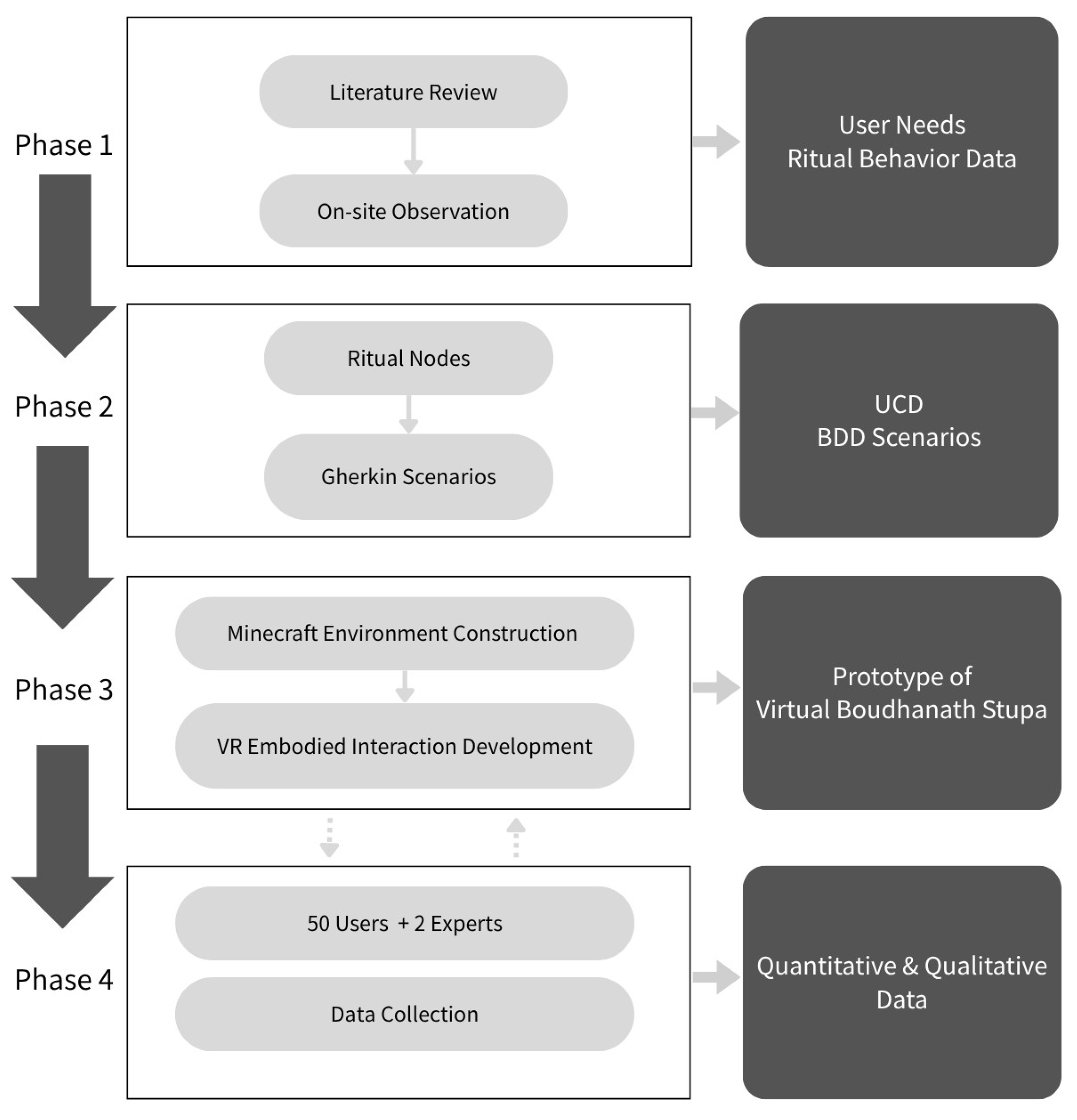
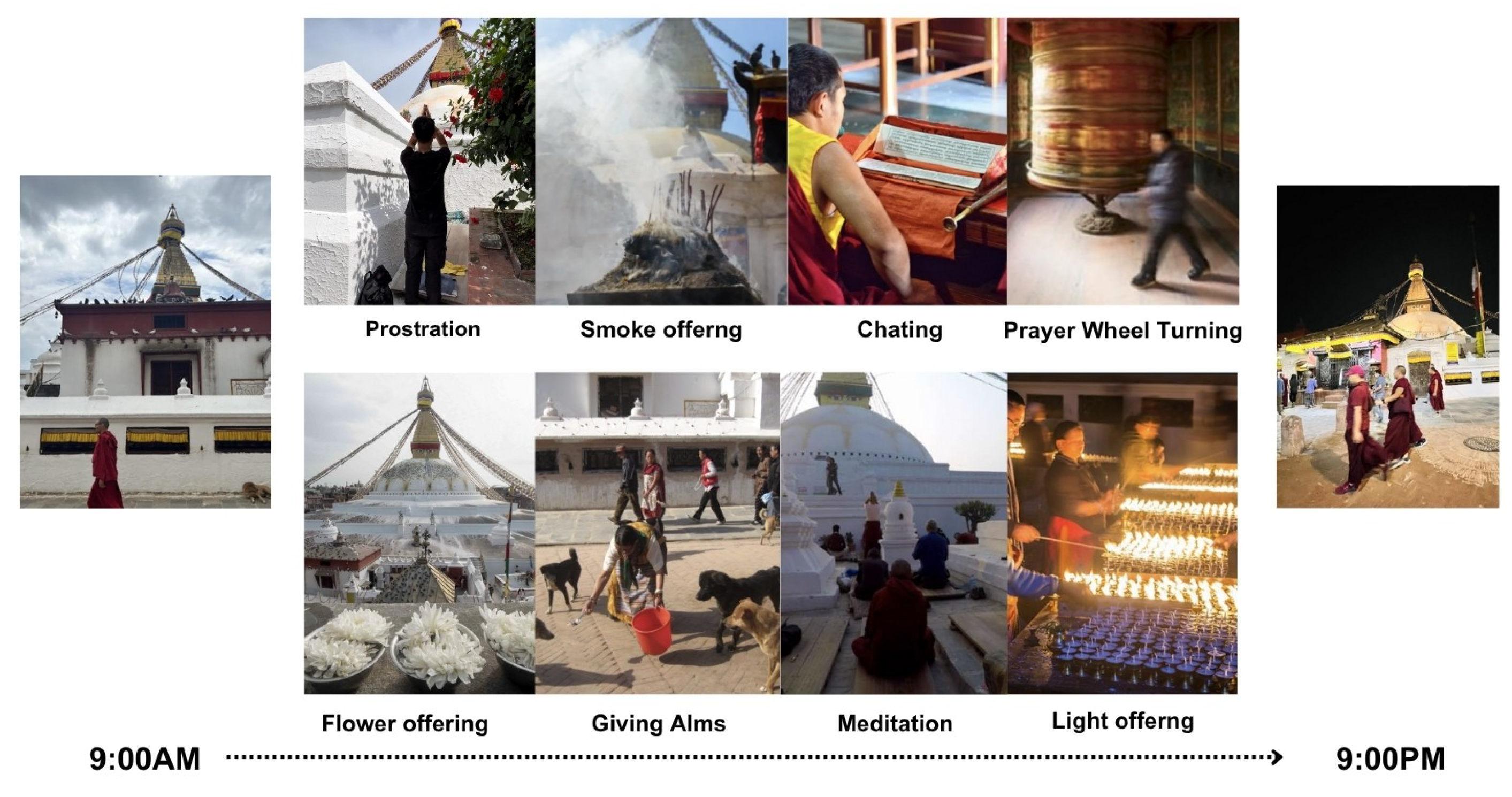
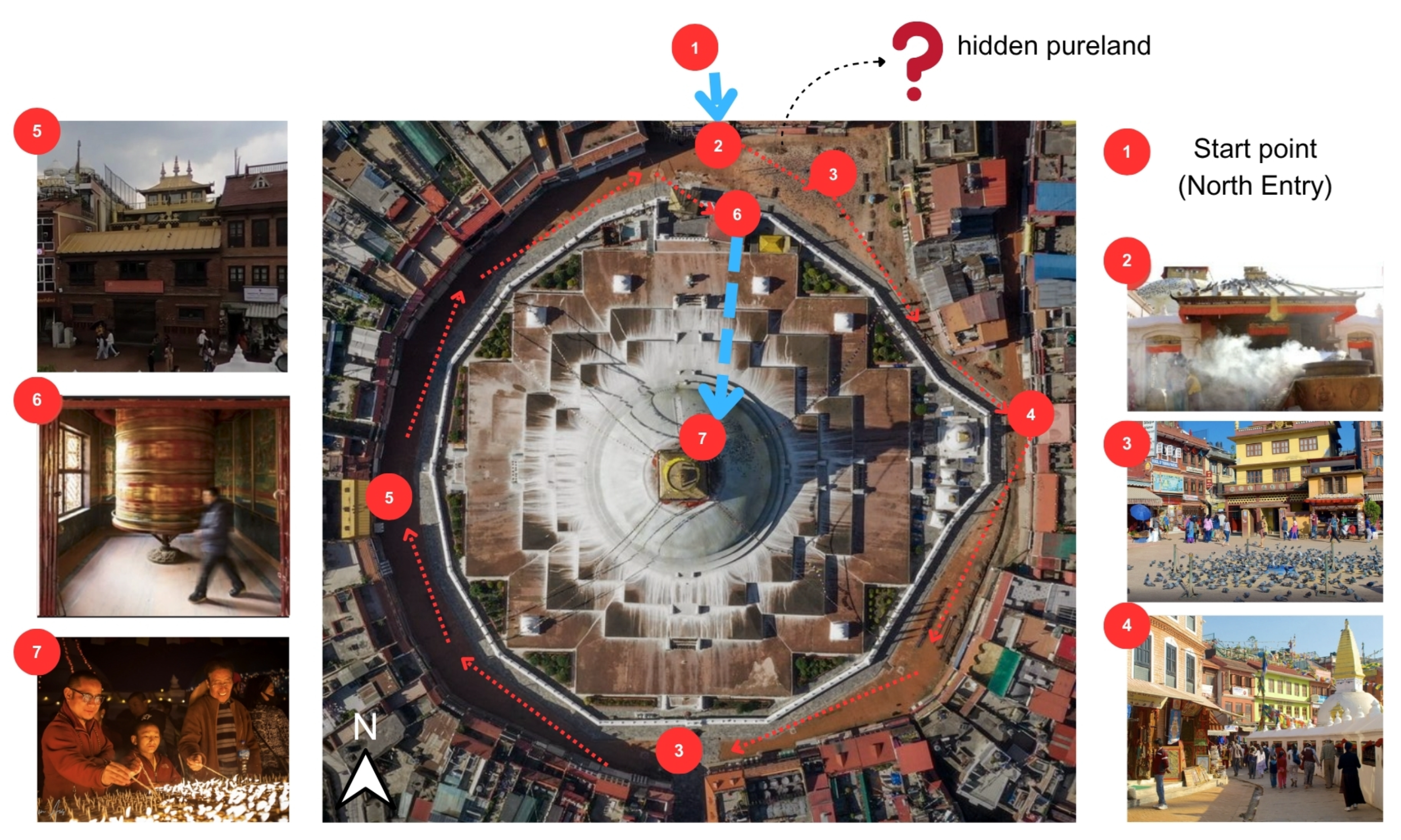
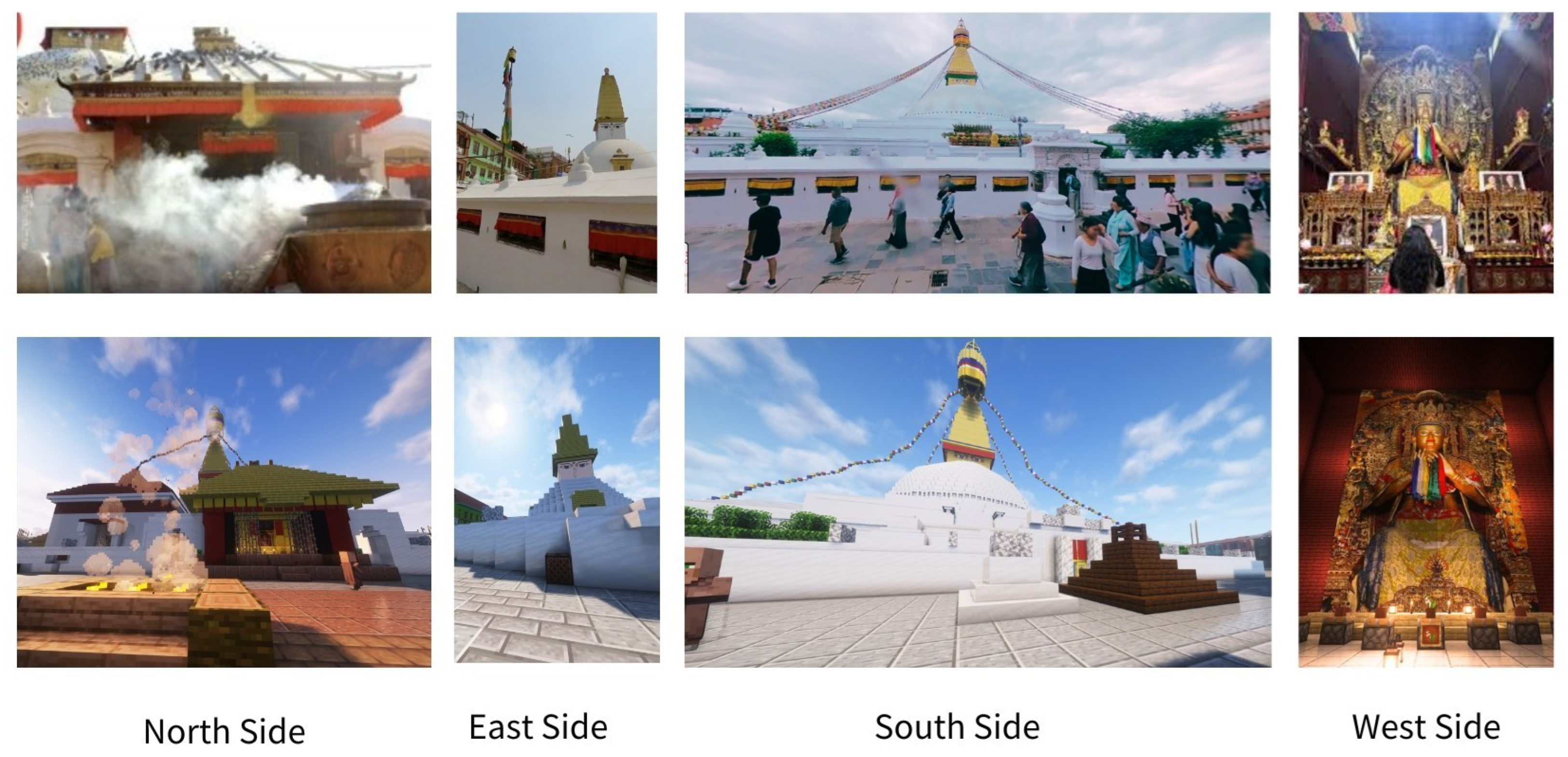
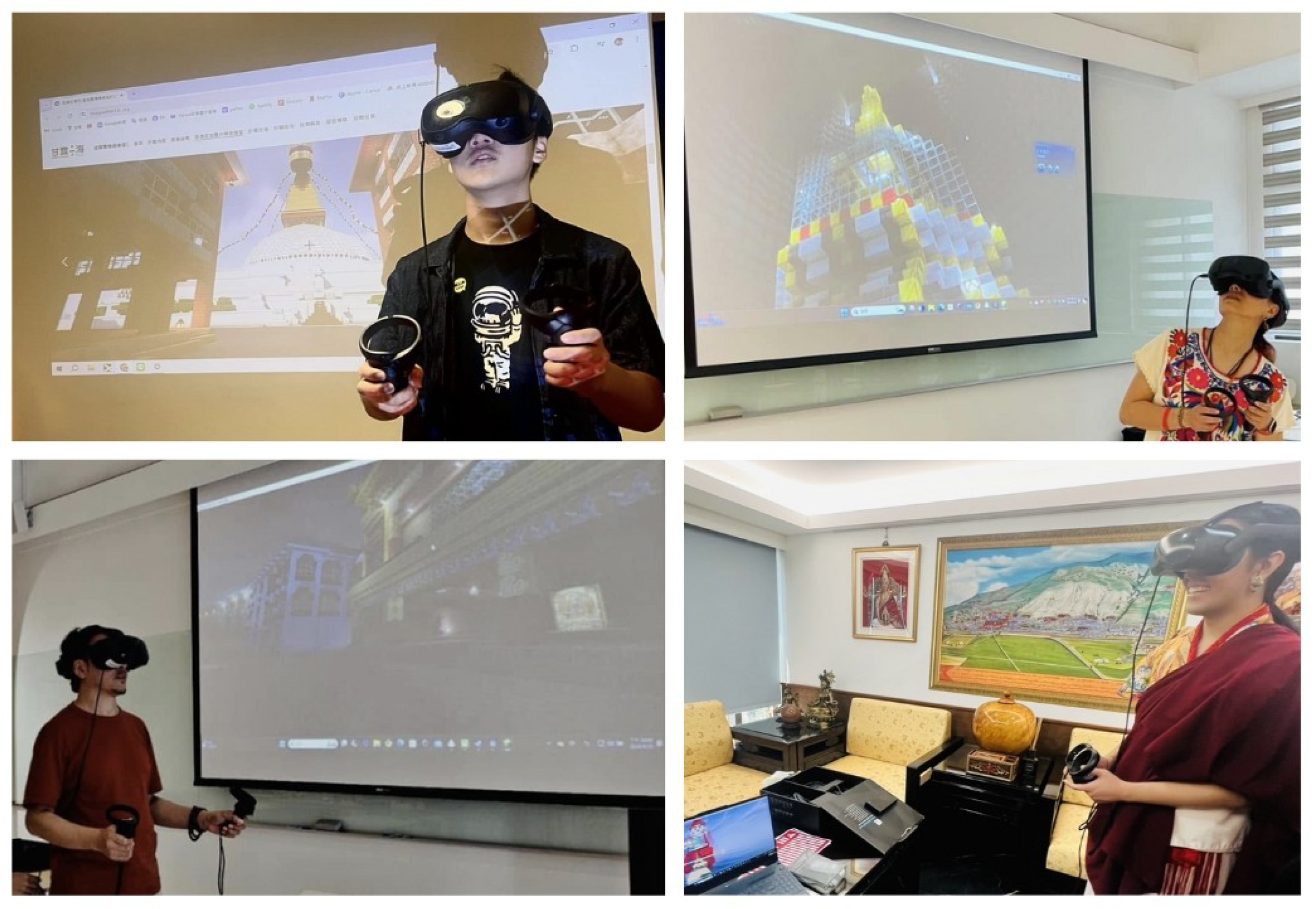
| Platform | Mechanics of Interaction | Dynamics of Ritual | Aesthetics of Pilgrimage | User Control and Freedom |
|---|---|---|---|---|
| Journey with Ignatius | Mobile app interface with clickable videos, articles, and audio; information browsing. | Linear daily/weekly devotional flow, following a set schedule. | Themed locations and saint biography excerpts create atmosphere through imagery and text. | Medium: Users choose reflection content, while pace and themes are preset by the platform. |
| Google Arts and Culture | Visual tour: Pan and zoom to explore high-resolution 360-degree panoramas or online exhibitions. | Passive viewing: User consumes rituals as linear cultural content and scenery. | Sensation and discovery: Evokes visual pleasure and joy in finding historical and artistic details. | Low: Predetermined paths and views allow for minimal personalized practice or exploration. |
| Muslim 3D | Desktop and mobile app; gamified tasks; 3D navigation and scripted triggers for actions. | Scripted simulation: Preset storyline with simplified ritual tasks. | Uses 3D simulated visuals and map-guided visits to sacred sites to evoke awe and reverence. | Medium: Free exploration within a main mapped route. |
| Pilgrimage to Pureland | Cultural VR embodied interaction: Exploration and movement via designated points. | Visual and task interaction: Combines viewing 2D murals with task-based actions like NPC conversations in a 3D scene. | Dunhuang’s murals hold major cultural significance, with sophisticated aesthetics that emphasize the spirituality of their depicted stories. | Medium: A guided narrative aimed at teaching the history and art of the Dunhuang murals. |
| The Holy City | VR embodied interaction: Gameplay includes completing challenges, solving puzzles, and unlocking clues at sacred sites. | Task-oriented: Integrated with observing ritual performances. Progression involves visiting key sites tied to specific faith practices. | Strong focus on visual authenticity through volumetric filming and photogrammetry. Highlights interfaith coexistence and shared values, enhancing the sense of spiritual unity. | High: Semi-guided exploration: Users travel through predefined sacred sites but can interact with puzzles and clues at each location. |
| 1. Start | |
|---|---|
| Given | the user is standing at the entrance |
| When | the user steps on the start “floor” |
| Then | the stupa shows |
| 2. Smoke Offering | |
| Given | the user is walking clockwise around the stupa |
| When | the user reaches the incense station |
| Then | incense smoke appears |
| 3. Giving Alms | |
| When | the user reaches a donation spot |
| Then | the user gives the food offering to an animal |
| Given | the animal is happy |
| 4. Chanting Mantras | |
| Given | the user reaches a music player desk |
| When | the user puts a record on the desk |
| Then | chanting audio plays |
| 5. Flower Offering | |
| Given | the user is going to a temple |
| When | the user sees a Bodhisattva statue |
| Then | the user puts a flower on the desk |
| 6. Spinning the Prayer Wheel | |
| Given | the user completes a full circumambulation loop |
| When | the user enters the prayer wheel room |
| Then | the user is positioned in front of the relic stupa |
| 7. Lighting a Lamp | |
| Given | the user stands in front of the relic stupa |
| When | the user puts the light on the offering table |
| Then | a firework effect is triggered to signify the completion of the pilgrimage |
| Hidden node | |
| Given | the user finds a Guru Rinpoche’s thangka |
| When | the user enters the thangka |
| Then | the user finds themself in a pure land |
| Dimension | Virtual Boudhanath Stupa | Corresponding Questions |
|---|---|---|
| Mechanics of Interaction | Provide a gamified task environment with embodied VR interaction. | M1: Easily perform the interactions. M2: The operations easy to use. M3: Reflects a sense of presence. MQ1: How many activities did I complete? |
| Dynamics of Ritual | Support non-linear ritual interactions such as circumambulation, offering, and prayer, allowing for autonomous path selection. | D1: Feel it achieves the benefits of physically circumambulating? D2: Believe this experience can genuinely accumulate merit? D3: This experience can make people more willing to understand the meaning of Buddhist rituals? DQ1: Which part of the entire experience did you find the most interesting, and why? DQ2: Which part of the entire experience did you find the least interesting, and why? |
| Aesthetics of Pilgrimage | In addition to sensory experiences, incorporate devotional expression, a sense of engagement, and meaning. | A1: Its aesthetic presentation is pleasant and comfortable. A2: This experience conveys the sensation of making a pilgrimage to the Boudhanath Stupa? A3: This experience is beneficial for engaging with a sacred site and provides emotional rewards? AQ1: Is it worth recommending to others? What adjectives would you use to recommend it? |
| User Control and Freedom | High: A high level of autonomy, allowing the experience to be arranged according to their individual intentions, pace, and goals. | U1: Your level of liking for this experience. U2: Feel this experience would motivate you to participate in virtual stupa building? UQ1: Please provide feedback on the strengths of this experience. UQ2: Please provide feedback on the weaknesses of this experience and suggestions. |
Disclaimer/Publisher’s Note: The statements, opinions and data contained in all publications are solely those of the individual author(s) and contributor(s) and not of MDPI and/or the editor(s). MDPI and/or the editor(s) disclaim responsibility for any injury to people or property resulting from any ideas, methods, instructions or products referred to in the content. |
© 2025 by the author. Licensee MDPI, Basel, Switzerland. This article is an open access article distributed under the terms and conditions of the Creative Commons Attribution (CC BY) license (https://creativecommons.org/licenses/by/4.0/).
Share and Cite
Lo, C.H.N. From Spatial Representation to Participatory Engagement: Designing a UCD–BDD Virtual Pilgrimage Environment. Heritage 2025, 8, 365. https://doi.org/10.3390/heritage8090365
Lo CHN. From Spatial Representation to Participatory Engagement: Designing a UCD–BDD Virtual Pilgrimage Environment. Heritage. 2025; 8(9):365. https://doi.org/10.3390/heritage8090365
Chicago/Turabian StyleLo, Chia Hui Nico. 2025. "From Spatial Representation to Participatory Engagement: Designing a UCD–BDD Virtual Pilgrimage Environment" Heritage 8, no. 9: 365. https://doi.org/10.3390/heritage8090365
APA StyleLo, C. H. N. (2025). From Spatial Representation to Participatory Engagement: Designing a UCD–BDD Virtual Pilgrimage Environment. Heritage, 8(9), 365. https://doi.org/10.3390/heritage8090365





